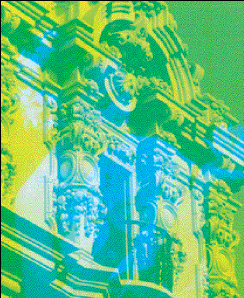
Colored Lights Reveal Hidden Images
Paula M. Powell
Color scientists at Xerox Corp.'s Wilson Center for Research and Technology in Webster, N.Y., have come up with a disappearing act that features high-quality color photographs. Under illumination with one color of light, a print reveals one detailed image, but a different image appears when the photo is illuminated by another color. Under conventional lighting, a third picture is seen against a background of intermixed colors.
The beauty of the technique, said researcher Robert Loce, is that its complexity lies in the specialized color-management software used to produce the hard copies of photographs. Other requirements are just a standard color printer that is calibrated for this type of printing and a controlled lighting environment that uses a characterized illuminant -- or light from a specific, narrow-wavelength band -- such as that produced by something as simple as a low-cost LED. Potential applications range from hidden messages on cereal boxes and T-shirts to security-related encoding.

Xerox's Switch-A-View technique enables the printing of several images on top of one another. One image is visible at a time under specific colors of light. For example, illuminating the print at right with blue light reveals an image of a woman, but under red light, the façade of a building appears.
Loce, who developed the printing method with colleagues Gaurav Sharma, Steven Harrington and Juliet Zhang, explained that one ordinarily wants to suppress the variations in a printed image that emerge when it is viewed under incandescent or fluorescent lighting or in daylight. With the new technique, called Switch-A-View, the goal instead is to magnify the different responses to different light sources and to create different effects with concealed images. These effects can include switchable random-dot stereogram three-dimensional viewing as well as simple animation.
 Also called illuminant multiplexed imaging, the method exploits the interaction of the illuminating light and the printing colorants, as well as the way our eyes adapt to illumination under narrow-band spectral power distribution. Under wideband, or white-light, illumination, Loce said, we see different colors in prints that are made with different colorant combinations. Images that are viewed under narrow-band illumination, however, appear to display varying levels of gray and little or no chro-ma. Because the absorption characteristics of the colorants differ in different spectral bands, their reflectance (or density) under different narrow-band illuminants also is different, he said.
Also called illuminant multiplexed imaging, the method exploits the interaction of the illuminating light and the printing colorants, as well as the way our eyes adapt to illumination under narrow-band spectral power distribution. Under wideband, or white-light, illumination, Loce said, we see different colors in prints that are made with different colorant combinations. Images that are viewed under narrow-band illumination, however, appear to display varying levels of gray and little or no chro-ma. Because the absorption characteristics of the colorants differ in different spectral bands, their reflectance (or density) under different narrow-band illuminants also is different, he said.
In early experiments, the scientists have produced several examples of multiplexed imaging, including two images using cyan, yellow and black colorants for viewing under red and blue narrow-band illumination; two images using magenta and cyan for viewing under green and red; one image with a flat field using cyan and black such that the image spatial variation is perceptible under red but disappears under blue; and a print using cyan, yellow and black that reveals two detailed images under red and blue illumination and that shows a Xerox "X" logo overlaid on a background of intermixed colors under conventional illumination.
Currently, the researchers can generate at least two detailed hidden images as well another characteristic, such as a watermark, working with red, green, blue and white light. The technique is not necessarily limited to this level of image layering, however, and with further developments in the color management software, they expect further hidden-image capability to become available.
Published: September 2003